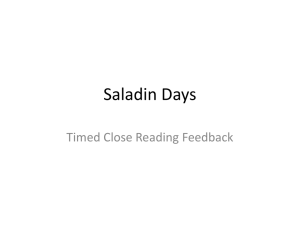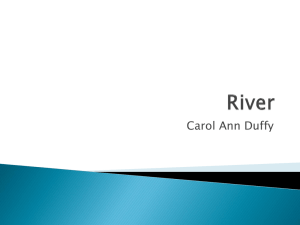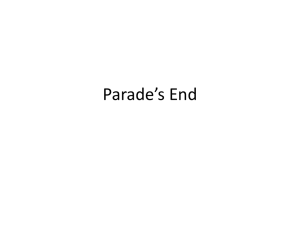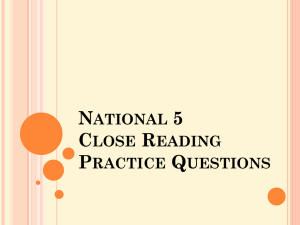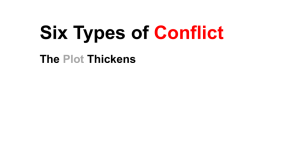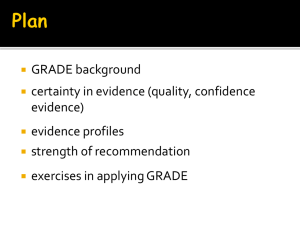Se7en opening title sequence analysis-mise en scene
advertisement
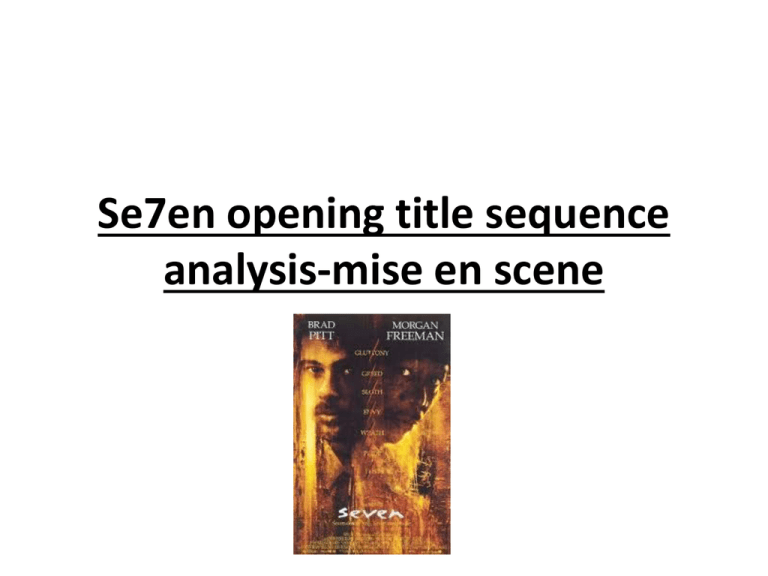
Se7en opening title sequence analysis-mise en scene Locations Location and how it is typical of the genre • The location is unknown due to the entire opening title sequence being filmed with close ups and extreme close ups. • We presume it to be the character’s home, warehouse or a hideaway building as it is inside. • It is typical of the genre because it instantly encourages the audience to ask questions about why it is kept a secret. It is a way that the director uses restricted narration-giving limited information to the audience. • The fact that the location appears to be a warehouse, etc, this suggests the film is set in an ordinary location, which is also a trait of thrillers. How it contributes to the representation of the characters • The unknown whereabouts of the setting emphasises a hidden identity of the character who uses it. • The unknown identity of this character suggests it is the main antagonist of the film. Lighting/ colour • • • • • • • Two images of hands on paper-one is dark and one is light, possibly signifying a fight between good and evil. Often dark and shadowy over the character’s work-this suggests that the character is an antagonist and is creating an evil scheme or crime. Red lighting over or surrounding a black and white image of unknown people-this suggests a sense of danger, violence and death; this is assumed to have been the main character in the sequence’s responsibility. Small drop of red blood falls onto a paper-this emphasises a sense of danger surrounding the character and that he is meticulous in the creation of his plan (he slices off the skin on the tips of his fingers to avoid putting finger prints on his work. Black highlighter- the colour suggests death and danger will be main themes in the film White font-the colour white appears ghostly; this could represent that a criminal is on the run and cannot be found be authorities. Darkly marked hands of character-suggests they are a criminal or someone with a dark secret. Costume and appearance of the characters • The character in the sequence has plastered fingertips because he slices the skin off-this suggests the character is hiding a dark secret as well as obviously his identity through fingerprints. The fact they are doing this suggests they are an antagonist of the film. • The character’s hands are darkly marked and stained and look rough- the rough look to their hands suggests he is violent and dangerous. The character’s marked hands suggest he is very hardworking in what they desire to achieve-currently a mystery to the audience. • Some people are featured in the form of photographs that the mysterious main character is using-the lighting, colour and the fact that the character is highlighting them (in black) could represent that they have died. Props Props • Pen and highlighters • Papers • Photographs • Blade-to cut off fingertip skin • Plasters How are they typical of the genre? • The blade illustrates that violence will be a recurring theme in the film (foreboding). • Photographs are often highlighted creating hidden identities of various people. They also suggest they are important to the rest of the narrative-they could be present/past targets, etc. • Pens, highlighters and paper are all typical as they illustrate the work ethic and obsession of various characters-in this case the antagonist. • The plasters on the character’s fingers show a sense of hidden identity-a common theme within thriller films. Props continued How do they add to the action? • The use of the blade creates tension in the audience as it creates a sense of foreboding for the remainder of the narrative (danger). • The use of stationery and photographs illustrates that someone has been planning a scheme for a long time-the audience question what the plan is whilst this also creates suspense. • The plasters add to the action because the audience think that if the character harms himself, how much harm does he put others in. They also suggest violence in the rest of the film. What additional information do they give us about the characters? • The blade shows the audience that the antagonist is violent and a severe threat to the public. • The plasters emphasise the character’s hidden identity-suggesting they are an antagonist. • The immense amount of stationery show that this character is a meticulous planner who is detailed, precise and sadistic. Actor’s performance-character • Character seems calm in his actions-no sudden movements or seemingly anxious actions. • Character seems methodical in the order he does his work and research • Character is careful when • Character uses a lot of detail in his work and research. What does this tell us about the social status of the characters? • The coarse hands of the character suggests they work manually, although they are obviously intelligent from the detail they work with. This therefore suggests the character is of a working class background and career. What does it tell us about the personality of the characters? • The character is meticulous about giving information about his identity away. • The character is obsessive because everything they do seems to be ordered in a specific away. • The detail the character uses suggests that they have completed a lot of planning and needs to be precise in the completion of the plan/crime itself. Conventional images to the film-clues to the forthcoming narrative • Blade-a blade is frequently used in thriller films as it conveys a sense of threat, danger and fear-despite the fact the character is using it to slice off their skin of their fingertips. The blade is a regular prop that causes suspense and tension in the audience as it suggests violence in the forthcoming narrative. • Photographs-these are also conventional features of thriller films; they show that the character appears to need or target them for something. However, due to the red lighting often being used when in the presence of a person’s photo-the audience presumes they are the injured or dead targets of the character. The photos also create tension as the audience ask questions relating to their importance and relevance to the narrative. • Blood- a single drop of blood falls onto a sheet of paper the character has been using for research. Although it’s use in the sequence is very subtle, this instantly conveys a sense of danger to the audience and connotes that the character is an antagonist. It also therefore signifies that violence will feature heavily in the narrative.
